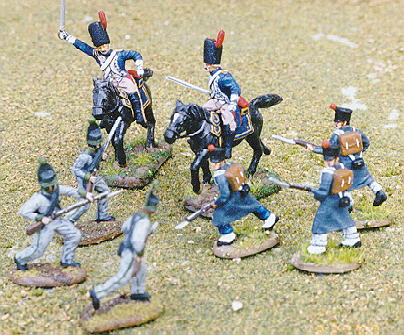



Webmaster's notes: French infantry battalions were composed of fusilier (center) companies and voltigeur and grenadier companies. There were several fusilier companies in a battalion but only one each of voltigeurs and grenadiers. These last were considered elite troops. The voltigeurs were usually smaller men and able to act independently. They were used as light infantry skirmishers in front of the main line, harassing the enemy, fighting enemy skirmishers or as scouts. The grenadiers were big men and used as shock troops or for shock action.
The fusilier companies were distinguished by blue facings, the voltigeurs by green or yellow facings and the grenadiers by red facings. The fusiliers were also distinguished by having a single shoulder belt, the elite voltigeurs and grenadiers had crossbelts.
Our Young Guard figures are post 1812 and single shoulder belted (they wore crossbelts before 1812), the other belt with the sabre-briquet was removed. These Young Guard figures can therefore be also used as French fusiliers in greatcoats. (Many thanks to both Alfred Umhey and Dan Peterson for providing this information.)
Several visitors have also commented that of the 3 sets of French Line Infantry on the market (Airfix, ESCI and Italeri) only Airfix's French Infantry are correctly uniformed. Prior to 1812, the French line infantry wore a coat with an inverted V front (revealing a white waistcoat with a single line of buttons underneath) and long tails. After 1812, the French line infantry wore a flat fronted coat with a double row of buttons (plastron) and short tails. Only Airfix's French line infantry has the correct combination of flat front and short tails. Both ESCI's and Italeri's French line infantry have the inverted V fronts and short tails, a uniform that did not exist. Interestingly, the pictures and painting guides on the back of ESCI's and Italeri's boxes show the correct pre-1812 uniform.
Some French light infantry (in blue breeches) had the V front and short tails, but they also had epaulettes, plumes and short gaiters.
Comments from visitor Peter Kogan:
Those sets (ESCI and Italeri), plus the Airfix set, contain one other inaccuracy by portraying all of the infantrymen as wearing "grands guetres", or black gaiters reaching above the knee. Such gaiters were part of the French line infantry uniform prior to 1812 (together with the open-fronted habit), but were replaced at that time by shorter gaiters that were knee-length. Therefore, French line infantry in Russia, Germany in 1813 or Waterloo did not wear such gaiters. Incidentally, many French line infantrymen also wore overalls (wool or linen, depending on the season) over their gaiters, so an even more accurate picture would be to take an ESCI or Italieri torso and put it on the lower body of one of the ESCI or Revell grenadiers with pants.
One other peeve, of sorts, about the French line infantry sets is that, aside from the matter with the wrong coat, they will only accurately portray French infantrymen from a short time period: 1807-1812. Before that time, of course, French fusiliers wore bicornes and, after that time, the line infantry wore the closed-front habit vestes. Although shakos look better than hats, it's annoying to try to do a diorama showing the Austerlitz or Jena campaigs (not to mention earlier campaigns) by decapitating ESCI Prussians and giving their heads to French infantrymen.